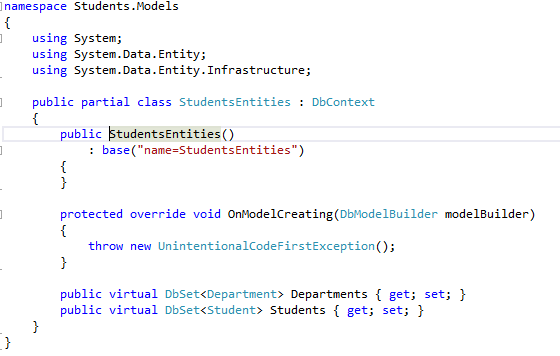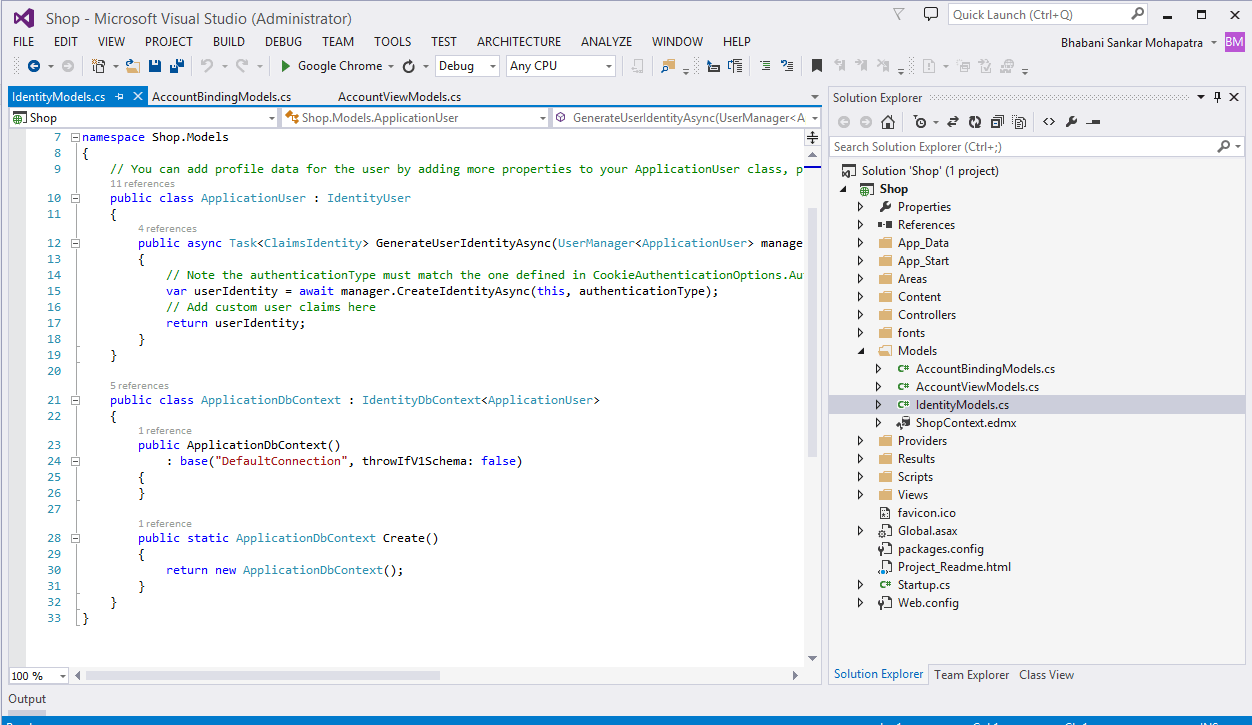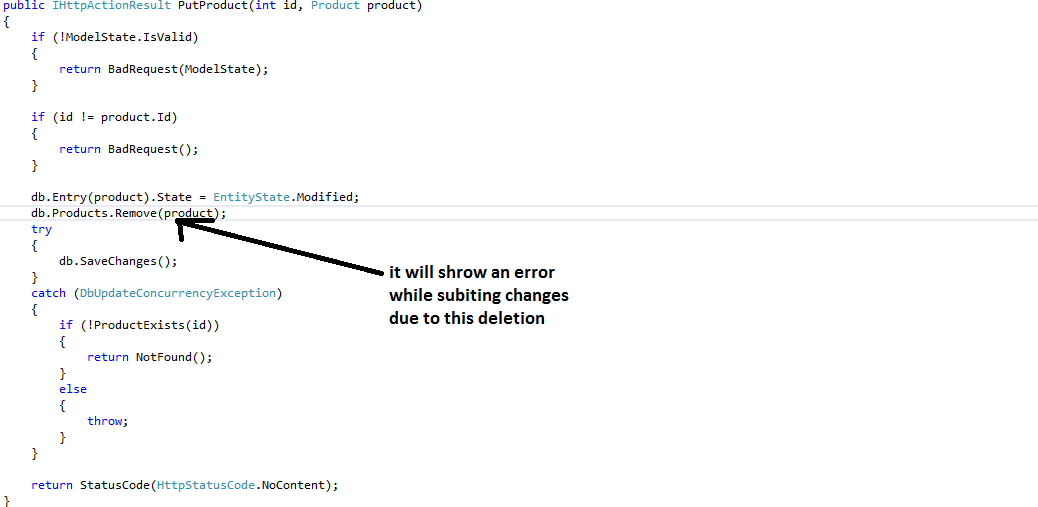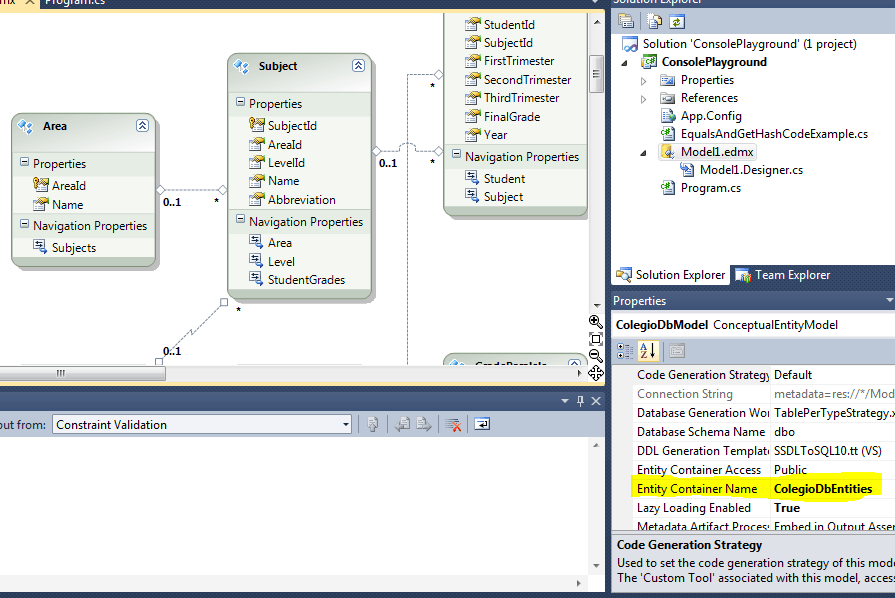This post is about Entity Framework Interview Questions that will explore various features, concepts and FAQs regarding Microsoft Entity Framework. It’s basically a collection of most frequently asked Entity Framework Interview Questions for developers. You can also explore some practical solutions implementing Entity Framework here:
- Building Your First MVC Application with Entity Framework [Part 1 & Part 2]
- Understanding Model First Approach in MVC5 with EF6
- What’s new in Entity Framework from Beginning to EF6
- A. EDM Generator (EdmGen.exe)
- B. ADO.NET Entity Data Model Designer
- C. Update Model Wizard
- D. Entity Data Model Wizard
- E. All of Above
- F. None of Above
For a complete online test and Practice Exams on Web Technologies, Click Here.
Correct Answer: B, D
Entity Framework Interview Questions List
- What is Entity Framework?
- What are the advantages of using Entity Framework?
- What is Entity Framework(EF) Core?
- What is the Nuget Package console command to install Entity Framework, if it’s not there in you project at that time?
- How to Install Entity Framework via NuGet Package in Visual Studio?
- Where do we use Virtual classes in Entity Framework DbContext Models?
- Entity Framework uses DbContext, How is it different from Object Context?
- What’s new in Entity Framework 6?
- Can we access a model in Entity Framework without primary key defined?
- Why do we use Lazy Loading in Entity Framework?
- Why DB Context models object disposal is important in Entity Framework?
- Can we do an insertion and deletion at the same block of code and then Apply save changes to them in a statement in Entity Framework?
- What are the development approaches are supported in Entity Framework?
- What is the query syntax we use to query an ADO.NET Entity Data Model?
- Is LINQ a feature of Entity Framework?
- Does Default New Project Creation under Internet Template Category of ASP.NET MVC have any DB Context Ready while creating the project?
- If you provide the Primary Key value while inserting record to Entity Framework, will that execute fine, or will it throw an error while the adding statement?
- What are the properties or Database Elements get copied in Dataset when Clone method is used?
- What is the role of a Self-Tracking Entities?
- Can you describe the feature of split entity in Entity Framework?
- What is the role of Entity Container in Entity Framework?
- Do we need to define any assembly refinances of entity framework if we use in web.config file?
More Entity Framework Interview Questions for beginners and Experienced
What is Entity Framework?
Microsoft Entity Framework (EF) is an Object Relational Mapping framework that provides an abstraction layer (a kind of mapping) between two incompatible systems (i.e. Object oriented programming languages with Relational databases). It enables us to interact with relational data in an object oriented way, meaning we can retrieve and manipulate data as strongly typed objects using LINQ queries.
Microsoft introduced Entity Framework with .NET Framework v3.5 Service Pack 1 supporting basic Object Relational Mapping support but later EF4 was introduced as second version aligning with .NET Framework v4.0.
Back to top
What are the advantages of using Entity Framework?
Main advantages of Entity Framework are:
- Separation of Concerns (SoC).
- LINQ is used as a common syntax for all object queries.
- Code Auto-Generation.
What is Entity Framework(EF) Core?
Entity Framework 7 rebranded as Entity Framework Core 1.0 is basically an object-relational mapping framework that allows us to communicate with database using .NET objects. It’s a lightweight, open-source and extensible framework for targeting .NET Core applications.
Entity Framework Core 1.0 has following additional features:
- Cross Platform i.e. can work with .net core application built for MacOS or Linux.
- Designed for disconnected/web services.
- Entity Framework Core is cloud optimized.
- EF Core is Device Optimized as being lightweight can work with SQLite.
- Support for relational and non-relational databases.
- EF Core also has Fluent API that enables a user to override the OnModeCreating strategy on a user’s context and makes it easy to figure the convention model.
- Built-In convention that effectively builds an initial model based on the entity classes.
- The EF Core features data annotations that are added to entity classes or properties to influence the EF model.
- It also has Snapshot change tracking properties based on recording the initial values of an entity as it is retrieved from the database.
- Notification change tracking enables a user’s entities to signal the change tracker in case property values are modified.
- Connection resiliency that automatically retries any failed database commands. Connection resiliency comes in handy for connection to SQL Azure which is prone to transient failures.
There are many key features those were available in EF 6.x but not included in Entity Framework Core 1.0.
- No Lazy Loading.
- Group By Translation – If query includes a group by clause, it will be omitted.
- Not Supporting stored procedures.
- No Graphical Modeling Tools supported.
- Spatial Data Types (a wrapper around a COM library).
- Simple Command Interception.
What is the Nuget Package console command to install Entity Framework, if it’s not there in you project at that time?
Following is the Nuget Package console command to install Entity Framework:
Install-Package EntityFramework -Version 6.1.1
Back to top
How to Install Entity Framework via NuGet Package in Visual Studio?
It’s quite simple to install Entity Framework via Nuget for our project in Visual Studio. For example, If I have just created a new project and want to install Entity Framework, below step by step approach will be helpful.
- Right click on the project and choose “Manage NuGet Packages…”.
![Manage NuGet Packages]()
- On Installation page, choose “Browse” Tab from top left and then enter “Entity Framework” in search box below that and click on search icon. It will list down all Entity Framework related results below.
![Installing Entity Framework]() As you can see, we have selected Entity Framework and all details (including version, author, License, Date Published etc.) of the selected item are displayed in right area.
As you can see, we have selected Entity Framework and all details (including version, author, License, Date Published etc.) of the selected item are displayed in right area. - In above screenshot, click on Install button. It will ask for a Review Changes going to be done, confirm by clicking “YES”.
![Review Install EF]()
- It followed by a License Acceptance confirmation. Just confirm by clicking “I Accept”.
![License Acceptance EF]()
- Once you accept the License, it will complete the installation displaying details in Visual Studio Output Window as shown in below screenshot.
![Entity Framework Installed]() Finally, you can see the successful installation message in Output Window. Once the installation is done successfully, you can see EntityFramework and EntityFramework.SqlServer in References of our project.
Finally, you can see the successful installation message in Output Window. Once the installation is done successfully, you can see EntityFramework and EntityFramework.SqlServer in References of our project.
Where do we use Virtual classes in Entity Framework DbContext Models?
We use Virtual classes in Entity Framework in context class where we define DBSet of corresponding table. As we can see easily in below code sample for Students and Departments:

Back to top
Entity Framework uses DbContext, How is it different from Object Context?
DbContext can be used for code first while Object Context doesn’t. It exposes the most commonly used features of ObjectContext.
Back to top
What’s new in Entity Framework 6?
- Customizing Code First Conventions.
- Logging of database commands.
- Stored Procedure Mapping.
- Asynchronous Queries and Save support.

With EF6, in applications with lots of tables and relationships defined, our context objects open faster. We should also be better insulated from dropped connections (at least, if the drop is transient and not permanent — nothing is going to help there). EF6 also generates SQL faster from LINQ queries than before (though it’s the same SQL that’s being generated as in earlier versions of EF, so your actual data access won’t be any faster or slower).
Back to top
Can we access a model in Entity Framework without primary key defined?
No, but we can access data.
Using Primary Key:
Student student = db.Students.Find(id);
Without Primary Key:
Student student = db.Students.Where(x=>x.StudentName==”Ahmad”);
Why do we use Lazy Loading in Entity Framework?
Entity Framework facilitates us to avoid huge, deep, highly-relational queries, so that the data will not heavy on the web.
Student student = db.Students.Find(id); //----> Step 1: Student record will load.
if(student != null){
student.Department; // ---> Step 2: Department details will be loaded.
}Note: As by default, lazy loading option is enabled in Entity Framework but that can cause major performance issues in some scenarios as below:
var students = db.Students.ToList(); // no department will be loaded.
foreach(var student in students)
{
student.Department; //department will be loaded here.
}
As for above scenario, student.Department will load department from SQL Server by firing a new SQL query for each iteration and it’s a performance degradation in case of large number of records.
We can disable Lazy loading (or in other words, enable eager loading) by using the following code:
db.ContextOptions.LazyLoadingEnabled = false;
Why DB Context models object disposal is important in Entity Framework?
Until it’s disposed, it will be holding resources that aren’t in. If not disposed then Garbage collector will free the space but in some instance it holds up.
Calling dispose method to clear memory.
Back to top
Can we do an insertion and deletion at the same block of code and then Apply save changes to them in a statement in Entity Framework?
Yes, WE CAN by using the below piece of code:

Here the student record will insert to db but not physically. When we call SaveChanges method then it actually insert in db and commit the transaction. If we delete before committing transaction nothing will change in database.
Back to top
What are the development approaches are supported in Entity Framework?
- Code First Approach – where code defines the database. Entity Framework handles creation. A complete detailed implementation of Entity Framework Code First Approach here.
- Database First Approach – regular approach used where database is first created or already exists.
- Model First Approach – where model is drawn first that further generate database scripts.
What is the query syntax we use to query an ADO.NET Entity Data Model?
We can use LINQ to Query ADO.Net Entity Framework. For Example:
Is LINQ a feature of Entity Framework?
Yes, following is the example to get student record from Section A.

The same in Entity Framework:
Student student = db.Students.Where(x=>x.Section==”A”);
Back to top
Does Default New Project Creation under Internet Template Category of ASP.NET MVC have any DB Context Ready while creating the project?
Yes, There is, as we can see in the below screenshot:
Back to top
If you provide the Primary Key value while inserting record to Entity Framework, will that execute fine, or will it throw an error while the adding statement?
Yes it will threw error if same a record present with same data. If identity is set then it will give error in any case.
Back to top
What are the properties or Database Elements get copied in Dataset when Clone method is used?
It will create a new object with same properties with a new instance.
Back to top
What is the role of a Self-Tracking Entities?
Self-tracking entity allows you to add code generated item:![]()
Back to top
Can you describe the feature of split entity in Entity Framework?
Entity splitting gives us the ability to take an entity in our model and split this entity into multiple database tables. When we query an entity, Entity Framework will create a query that Automatically joins the related physical tables for us.
Back to top
What is the role of Entity Container in Entity Framework?
Entity container is a logical grouping of entity sets, association sets, and function imports. The following must be true of an entity container defined in a conceptual model:
At least one entity container must be defined in each conceptual model. The entity container must have a unique name within each conceptual model.
Do we need to define any assembly references of entity framework if we use in web.config file?
Yes, that is necessary:
More Entity Framework Interview Questions including Entity Framework Core
LINQ to SQL Vs Entity Framework?
Following table clearly explains the difference between LINQ to SQL Vs Entity Framework:
| Entity Framework | LINQ to SQL |
| Work with any database including SQL Server, Oracle, MySQL, DB2 etc. | Works but limited to SQL Server. |
| Entity Framework works well in enterprise scenarios where requirement is to develop a loosely coupled application. | LINQ to SQL is good in rapid application development scenarios but follows a tightly coupled approach. |
| Entity Framework maintain a conceptual model that actually maps to storage model using a mapping. So, it’s possible that multiple EF classes map to one table or multiple tables map to one EF class. | A LINQ Entity directly maps to one SQL Server table only. In order to maintain a relationship, it generates a .dbml file. |
| Can generate database from model and it’s a key feature. | Generate database from model is not possible. |
- Learn ASP NET MVC 5 step by step [Maruti Makwana, Corporate Trainer]
28 Lectures, 2.5 Hours Video, Intermediate Level
Very easy to learn video series on Asp.Net MVC 5 Specially for those who are familiar with Asp.Net Web forms. - AngularJS for ASP.NET MVC Developers [Brett Romero]
10 Lectures, 1 hour video, Intermediate Level
The Fastest Way For .NET Developers To Add AngularJS To Their Resume - ASP.NET with Entity Framework from Scratch [Manzoor Ahmad, MCPD | MCT]
77 Lectures, 10 hour video, All Level
Latest approach of web application development - Comprehensive ASP.NET MVC [3D BUZZ]
34 lectures, 14 Hours Video, All Levels
From zero knowledge of ASP.NET to deploying a complete project to production.
Concluding Notes:
Again, this is my prepared list of important Entity Framework Interview Questions but reader can suggest/contribute more related concept area. I’ll be more happy to add those questions/concepts and update the Entity Framework Interview Questions list.
More Related Articles:
- Building your first ASP.NET MVC Application
- Top New Features of ASP.NET vNEXT
- Model-First Approach with MVC5 and Entity Framework 6
- Your First SPA application with AngularJS and Web API
- New Features in Visual Studio 2015
Top Web Developer Interview Questions and Answers Series:
- Top 10 ASP.NET MVC Interview Questions
- Top 10 ASP.NET Web API Interview Questions
- Top 10 HTML5 Interview Questions
- Top 10 ASP.NET Interview Questions
- Comprehensive Series of ASP.NET Interview Questions
- Top 10 ASP.NET Web API Interview Questions
- Top 10 ASP.NET AJAX Interview Questions
- Top 10 WCF Interview Questions
- Comprehensive Series of WCF Interview Questions
- Top 20 AngularJS Interview Questions
ASP.NET MVC Jobs [Updated Daily]
|
C# developer with strong SQL
|
Redmond, WA | 01-December-2016 |
|
Programmer / Analyst
|
Hillsboro, OR 97124 | 02-December-2016 |
|
C# .Net Software Developer (HV SD)
|
Seattle, WA | 29-November-2016 |
|
Software Design Engineer 3
|
Redmond, WA | 02-December-2016 |
|
Software Development Engineer(C# & Azure Cloud Service)
|
Redmond, WA | 01-December-2016 |
|
Sr .NET Developer
|
Stamford, CT | 02-December-2016 |
|
Full stack Developer
|
Redmond, WA | 21-November-2016 |
|
Sr Developer, Software .NET
|
Bellevue, WA | 07-October-2016 |
|
Full Stack Developer
|
Kirkland, WA 98033 | 18-November-2016 |
|
Sr .Net Developer with Xamarin Experience (HRBLJP00000342)
|
Los Angeles, CA 90017 | 28-November-2016 |
|
Sr. Web Applications Developer
|
Aliso Viejo, CA | 27-November-2016 |
|
Application Developer
|
Troy, OH | 03-December-2016 |
|
Project-Application Developer I
|
Bristol, CT 06010 | 03-December-2016 |
|
Application Developer (Journeyman)
|
Reston, VA 20190 | 02-December-2016 |
|
Application Developer
|
Los Angeles, CA | 01-December-2016 |
|
Sr. Software Engineer
|
Redmond, WA 98052 | 29-September-2016 |
|
.NET Software Developer
|
Austin, TX | 01-December-2016 |
|
Hiring Sr.net Developer at Boston, MA
|
Boston, MA | 18-November-2016 |
|
.NET Software Engineer with Angular (no C2C)
|
Reston, VA | 02-December-2016 |
|
.NET Software Developer
|
Charlotte, NC 28262 | 30-November-2016 |
|
Software Engineer (JavaScript/ASP.Net)
|
Salt Lake City, UT | 02-December-2016 |
|
Application Developer
|
Reston, VA | 27-November-2016 |
|
C# .Net Software Developer (HV MSP)
|
Houston, TX | 29-November-2016 |
|
C# .Net Software Developer (HV SD)
|
Portland, OR | 29-November-2016 |
|
C# .Net Software Developer (HV MSP)
|
Ann Arbor, MI | 29-November-2016 |
The post Top 20 Entity Framework Interview Questions – MUST HAVE appeared first on Web Development Tutorial.

 As you can see, we have selected Entity Framework and all details (including version, author, License, Date Published etc.) of the selected item are displayed in right area.
As you can see, we have selected Entity Framework and all details (including version, author, License, Date Published etc.) of the selected item are displayed in right area.

 Finally, you can see the successful installation message in Output Window. Once the installation is done successfully, you can see EntityFramework and EntityFramework.SqlServer in References of our project.
Finally, you can see the successful installation message in Output Window. Once the installation is done successfully, you can see EntityFramework and EntityFramework.SqlServer in References of our project.

